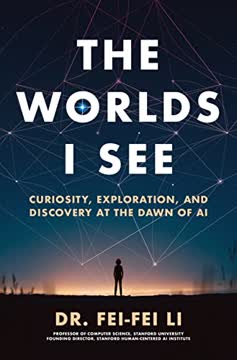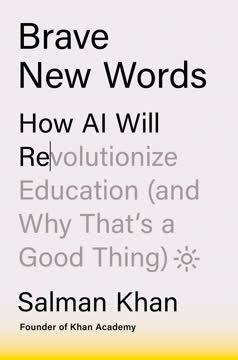Key Takeaways
1. Digital transformation is a continuous journey, not a one-time event
Business leaders will be digitally transforming their companies for the rest of their careers.
Ongoing evolution: Digital transformation is not a finite project but a continuous process of adapting to rapidly changing technologies and market conditions. It requires organizations to constantly evolve their capabilities, processes, and culture to remain competitive in the digital age.
Fundamental realities: Two key factors drive the continuous nature of digital transformation:
- Constant technological change: New technologies, architectural paradigms, and software development methods emerge regularly.
- Complexity of implementation: Transforming an organization's core operations and culture is challenging and time-consuming.
Value creation: Successful digital transformations can lead to significant financial rewards. For example:
- Digital leaders in banking saw 8.2% annual growth in total return to shareholders, compared to 4.9% for laggards.
- Top-performing companies achieve substantial improvements through digital practices, with 70% using advanced analytics for proprietary insights.
2. Develop a business-led roadmap to guide your digital transformation
Creating the transformation roadmap is the blueprint for a successful digital and AI transformation.
Strategic alignment: A well-crafted roadmap ensures that digital initiatives are aligned with business objectives and have clear value propositions. It helps prioritize efforts, allocate resources effectively, and maintain focus on high-impact areas.
Key components: An effective digital transformation roadmap should include:
- Clear vision and objectives
- Prioritized business domains for transformation
- Specific digital solutions and use cases
- Required capabilities and resources
- Implementation timeline and milestones
- Expected outcomes and success metrics
Executive commitment: The roadmap serves as a contract among leadership, requiring commitment to:
- Invest in foundational enterprise capabilities
- Allocate necessary resources (financial and human)
- Drive cross-functional collaboration
- Measure and track progress regularly
3. Build a digital talent bench through strategic hiring and upskilling
You can't outsource your way to digital excellence.
In-house expertise: Building a strong internal digital talent bench is crucial for developing competitive digital capabilities. This requires a combination of strategic hiring, upskilling existing employees, and creating an environment where digital talent can thrive.
Talent strategy:
- Identify core digital roles and skills needed
- Develop a compelling employee value proposition for digital talent
- Create flexible career paths for both managerial and technical tracks
- Implement continuous learning programs to keep skills current
Talent acquisition and retention:
- Establish a dedicated Talent Win Room to drive digital talent initiatives
- Streamline recruiting processes to compete for top talent
- Offer competitive compensation and benefits packages
- Foster a culture of innovation and continuous learning
4. Adopt an agile operating model to increase speed and flexibility
From doing agile to being agile.
Organizational agility: Implementing an agile operating model goes beyond adopting specific methodologies. It requires a fundamental shift in how work is organized, decisions are made, and value is delivered.
Key elements of agile transformation:
- Cross-functional teams (pods) with end-to-end accountability
- Iterative development and continuous improvement
- Empowered decision-making at the team level
- Focus on delivering customer value quickly
Scaling agile:
- Digital factory model: For organizations starting their agile journey
- Product and platform model: For more mature digital organizations
- Enterprise-wide agility: For companies seeking to transform their entire operating model
5. Implement a decoupled technology architecture for innovation at scale
A distributed and decoupled architecture is needed to enable teams to assemble modular and reusable components.
Architectural principles: A modern technology architecture should support flexibility, stability, and speed to enable rapid innovation across the organization.
Key architectural shifts:
- From point-to-point to decoupled: Use APIs to enable flexible integration
- From manual to automated: Implement infrastructure as code and automated delivery pipelines
- From fixed to evolving: Adopt modular, best-of-breed components
- From batch to real-time: Leverage real-time data processing capabilities
Cloud adoption: Carefully consider which workloads to migrate to the cloud based on business value and feasibility. Implement a solid cloud foundation, including:
- Base cloud capabilities
- Isolation zones
- Application patterns
- FinOps capabilities for cost optimization
6. Embed data everywhere to enable data-driven decision making
Data products are the secret sauce for scaling.
Data as a strategic asset: Treating data as a product and embedding it throughout the organization enables faster, more informed decision-making and unlocks new sources of value.
Key data capabilities:
- Data strategy: Identify and prioritize high-value data domains
- Data products: Create reusable, high-quality data assets
- Data architecture: Implement a modern data platform (e.g., data lakehouse)
- Data governance: Establish clear ownership and quality standards
Data-driven culture: Foster a culture where data is used to inform decisions at all levels of the organization through:
- Data literacy programs
- Easy access to relevant data and analytics tools
- Recognition and rewards for data-driven decision making
7. Drive adoption and scaling to realize the full value of digital solutions
Capturing value requires you to go beyond addressing user needs to changing the underlying business model.
Adoption focus: Successful digital transformations require as much effort on driving adoption and scaling as on developing solutions.
Key adoption strategies:
- User-centric design: Create solutions that address real user needs and pain points
- Change management: Implement targeted interventions to drive behavior change
- Business model adaptation: Identify and address broader organizational changes required for success
Scaling approach:
- Design solutions for reusability and easy adaptation
- Develop a structured replication method (assetization)
- Choose appropriate scaling archetypes (linear waves, exponential waves, or big bang)
- Invest in capabilities to support rapid scaling across the organization
8. Manage digital risks and build trust to ensure long-term success
Digital trust means confidence that an organization protects consumer data, enacts effective cybersecurity, offers trustworthy AI-powered products and services, and provides transparency around AI and data usage.
Digital trust imperative: As organizations become more digital and data-driven, managing risks and building trust with customers, employees, and regulators becomes crucial for long-term success.
Key digital trust capabilities:
- Risk triaging: Identify and prioritize digital risks
- Policy development: Establish comprehensive digital trust policies
- Operationalization: Embed controls into development processes and automate where possible
- Awareness and training: Build a culture of digital responsibility across the organization
Continuous improvement: Regularly assess and update digital trust practices to address evolving risks and stakeholder expectations. Proactively communicate efforts to build transparency and confidence with key stakeholders.
Last updated:
FAQ
What's Rewired: The McKinsey Guide to Outcompeting in the Age of Digital and AI about?
- Digital Transformation Focus: The book is a comprehensive guide on leveraging digital technologies and AI to gain a competitive edge. It emphasizes integrating technology into business processes and culture.
- Structured Framework: It outlines a framework combining talent management, technology adoption, and new operating models to create a cohesive digital transformation strategy.
- Real-World Case Studies: The authors use case studies from various industries to illustrate successful transformations, providing practical insights into implementing digital strategies.
Why should I read Rewired: The McKinsey Guide to Outcompeting in the Age of Digital and AI?
- Essential for Leaders: It's a must-read for executives responsible for driving digital change, equipping them with the knowledge and tools for successful transformations.
- Comprehensive Framework: The book offers a detailed roadmap covering all aspects of digital transformation, making it a valuable reference for anyone involved in the process.
- Timely Insights: As digital and AI technologies evolve, the insights provided are both timely and timeless, addressing current challenges and future trends.
What are the key takeaways of Rewired: The McKinsey Guide to Outcompeting in the Age of Digital and AI?
- Continuous Transformation: Digital transformation is an ongoing journey, requiring organizations to adapt continuously to new technologies and market demands.
- Importance of Talent: Having the right talent is crucial for successful digital transformation, with a focus on building a strong internal bench of digital experts.
- Integrated Capabilities: Organizations need to develop integrated capabilities across technology, data, and talent to achieve business objectives.
What specific methods does Rewired recommend for digital transformation?
- Agile Pods: The book advocates for cross-functional teams empowered to deliver digital solutions, focusing on mission-based outcomes.
- OKRs Framework: It introduces the Objectives and Key Results framework to align teams on goals and track progress, ensuring efforts deliver customer value.
- Decoupled Architecture: Adopting a decoupled architecture allows for flexibility and scalability in application development, enabling faster innovation.
How does Rewired define digital and AI transformation?
- Ongoing Process: It's defined as the continuous development of capabilities that enhance customer experience and reduce costs, not a one-time project.
- Focus on Value Creation: The transformation aims to create sustainable competitive advantages by leveraging technology and data.
- Leadership Involvement: Active involvement from top leadership is required to align vision and strategy, fostering a culture of change and innovation.
What are the best quotes from Rewired and what do they mean?
- “Digital transformation is a journey...”: Emphasizes that transformation is an ongoing process requiring constant adaptation.
- “You can’t outsource your way...”: Highlights the importance of building internal capabilities rather than relying solely on external vendors.
- “Every executive will be working...”: Reflects the necessity for leaders to embrace technology as a core component of their strategy.
What challenges do organizations face during digital transformation according to Rewired?
- Misalignment Among Leadership: A lack of shared understanding among executives can lead to fragmented efforts and ineffective execution.
- Resource Allocation: Companies often struggle with appropriately scoping their transformation efforts, hindering progress and diluting impact.
- Cultural Resistance: Resistance to change within the organization can impede transformation efforts, requiring active change management.
How does Rewired suggest organizations build their talent bench?
- Strategic Talent Planning: Conduct a thorough assessment of existing talent and identify skill gaps needed for digital transformation.
- Hiring and Retention: Focus on developing a compelling employee value proposition to attract and retain top digital talent.
- Fostering a Learning Environment: Invest in tailored training programs and create pathways for career advancement to keep digital talent engaged.
What role does technology play in the strategies outlined in Rewired?
- Foundation for Innovation: Technology is a critical enabler of digital transformation, providing tools and infrastructure for agile development.
- Decoupled Architecture: Emphasizes the importance of flexibility and scalability in application development to support rapid deployment.
- Automation and Efficiency: Advocates for automating processes to enhance efficiency and reduce manual errors, accelerating time to market.
How can organizations ensure successful adoption of digital solutions as per Rewired?
- User-Centric Design: Design solutions with the end user in mind, engaging them early to ensure solutions meet their needs.
- Change Management: Develop comprehensive strategies addressing technical, process, and human aspects of transformation to drive adoption.
- Tracking and Measuring Impact: Establish metrics to track success and impact on business outcomes, allowing for continuous improvement.
What is the digital roadmap mentioned in Rewired?
- Strategic Blueprint: It serves as a strategic plan outlining steps to achieve digital transformation goals, including timelines and key milestones.
- Alignment with Business Goals: Ensures digital initiatives align with overall business strategy, prioritizing projects that deliver the most value.
- Continuous Review and Adaptation: The roadmap should be regularly reviewed and updated based on progress and market conditions.
How does Rewired define digital trust?
- Confidence in Data Protection: Refers to consumer confidence in an organization’s ability to protect data and ensure privacy.
- Transparency and Accountability: Requires organizations to be transparent about data use and AI technologies, communicating data handling practices.
- Proactive Risk Management: Emphasizes identifying and mitigating risks associated with digital and AI initiatives, maintaining customer trust.
Review Summary
Rewired receives mixed reviews, with an average rating of 3.96 out of 5. Some readers praise its comprehensive guide to digital transformation, offering valuable insights for business leaders. Others criticize it for being too technical, lacking concrete examples, and filled with vague platitudes. Positive reviews highlight the book's strategic roadmap and actionable advice, while critics argue it's superficial and overly prescriptive. The book is seen as most useful for executives and high-level management in large organizations seeking to implement digital and AI strategies.
Similar Books










Download PDF
Download EPUB
.epub digital book format is ideal for reading ebooks on phones, tablets, and e-readers.




